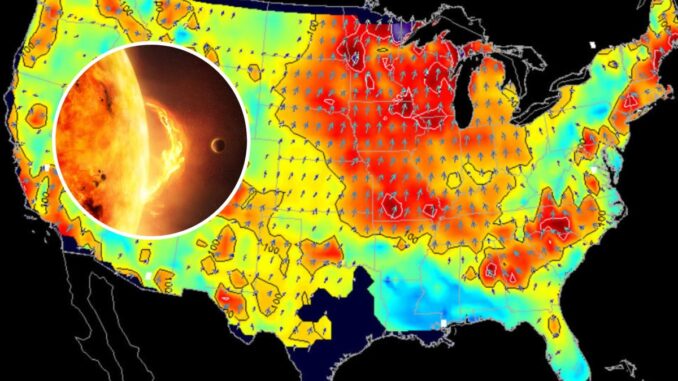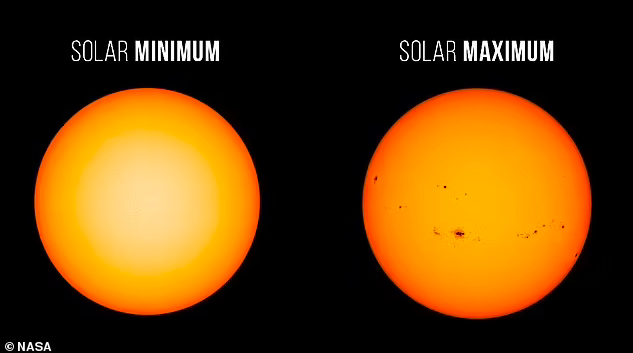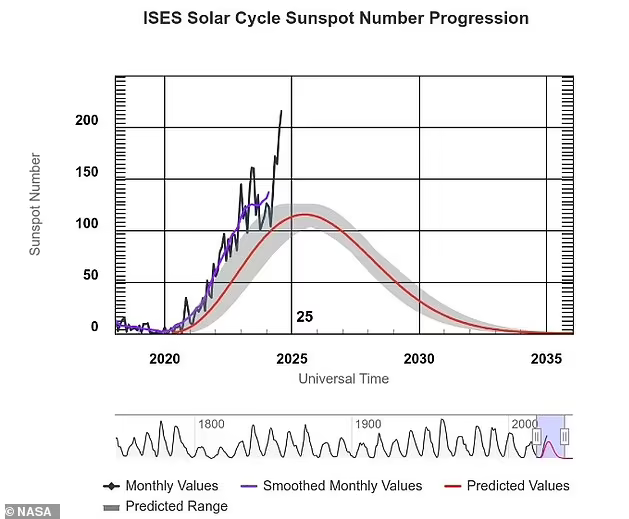
NASA has issued a stark warning about powerful solar storms expected to surge over the next year, with the potential to knock out global internet services and power grids. These intense solar events could plunge the world into chaos, disrupting daily life, communications, and essential systems on an unprecedented scale.
In a teleconference this week, NASA, the National Oceanic and Atmospheric Administration (NOAA), and the Solar Cycle Prediction Panel confirmed that the sun has reached its solar maximum period, which is likely to continue for the next twelve months.

BYPASS THE CENSORS
Sign up to get unfiltered news delivered straight to your inbox.
Latest Video
‘During solar maximum, the number of sunspots, and therefore, the amount of solar activity, increases,’ said Jamie Favors, director of NASA’s space weather program.
However, the exact time and date the solar maximum activity will peak is yet to be determined.
Elsayed Talaat, director of space weather operations at NOAA, added: ‘While the sun has reached the solar maximum period, the month that solar activity peaks on the sun will not be identified for months or years.’
 Every 11 years, the sun goes through what’s known as ‘solar maximum’, when many bizarre dark spots appear on its surface
Every 11 years, the sun goes through what’s known as ‘solar maximum’, when many bizarre dark spots appear on its surfaceFortunately, solar storms are not dangerous to humans.
But, they have the capacity to impact satellites in orbit as well as power grids on Earth, resulting in catastrophic cyber and power outages across continents.
‘The chances of these solar storms increases when the number of sunspots are high,’ Dr Dibyendu Nandi, a physicist from the IISER Kolkata Center of Excellence in Space Sciences in India, told MailOnline.
‘The most intense storms can sometimes result in catastrophic orbital decay of low Earth orbiting satellites and disrupt satellite based services such as communications and navigational networks.
‘They can also induce strong disturbances in the geomagnetic field tripping electric power grids located in high latitude regions.
‘Of course, they also create beautiful auroras so we can expect 2024 to be a good year for aurora hunters.’

A 2021 study published by a University of California Irvine scientist found the internet could be crippled for weeks in the wake of a severe solar storm.
This is due to vulnerabilities in the world’s massive network of submarine communications cables.
The electromagnetic fluctuations caused by intense solar storms cannot directly harm the fibre optic cables that make up the backbone of the internet.
However, they do have the potential to take out the signal boosters dotted along undersea cables that are necessary to maintain connections over large distances.
 Every 11 years the Sun’s magnetic field flips, meaning the Sun’s north and south poles switch places. The solar cycle affects activity on the surface of the Sun, increasing the number of sunspots during stronger (2001) phases than weaker (1996/2006) ones
Every 11 years the Sun’s magnetic field flips, meaning the Sun’s north and south poles switch places. The solar cycle affects activity on the surface of the Sun, increasing the number of sunspots during stronger (2001) phases than weaker (1996/2006) onesThe study predicted the likelihood of solar storm capable of causing catastrophic disruption occurring in the next 10 years is between 1.6–12 per cent.
In 1859, a massive solar storm known as the Carrington event sent a powerful solar ejection toward Earth, disrupting communications on the ground.
If such an event were to happen in today’s world, the effects would be catastrophic on our communications systems.
Lesser storms hit in 1921 and 1989 – the latter of which notably knocked out the power grid ran by Hydro-Québec, causing a nine-hour blackout in the northeast of Canada.
Source link


